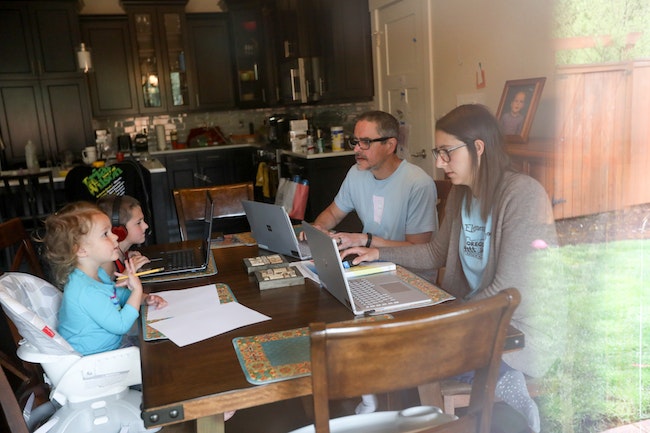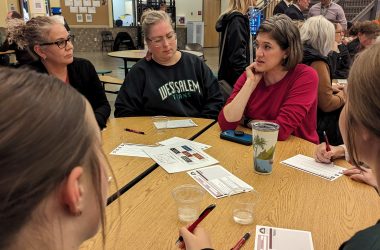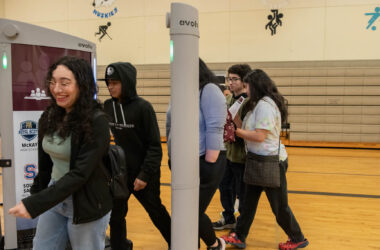 Seen through a sliding glass door, Noah Hall, wife Jessica and children Evan, 6, and Ruby, 2, sit at the kitchen table of their Salem home on Wednesday, April 23. The Halls are both elementary school teachers who are currently teaching classes from phone via video while also caring for Ruby and helping Evan with his kindergarten classwork. (Amanda Loman/Salem Reporter)
Seen through a sliding glass door, Noah Hall, wife Jessica and children Evan, 6, and Ruby, 2, sit at the kitchen table of their Salem home on Wednesday, April 23. The Halls are both elementary school teachers who are currently teaching classes from phone via video while also caring for Ruby and helping Evan with his kindergarten classwork. (Amanda Loman/Salem Reporter)
Teachers are contemplating how they can teach kids phonics while wearing a mask.
Students may find choir or band classes held in school lunchrooms or outside.
Parents who have struggled to work from home while caring for young children will likely have to find childcare several days per week.
And school district administrators are crunching numbers to see how they can get students to school in small groups with no money for extra buses or drivers.
On Wednesday, Oregonians got a first glance at what schools may look like in the fall as many districts, including Salem-Keizer, prepare to bring students back into classrooms.
The guidelines will change nearly every aspect of schooling from recess to history classes, all with the goal of minimizing the number of people each student is in contact with during a day.
Salem-Keizer will pursue a “hybrid” form of school, assistant superintendent Kraig Sproles said, trying to maximize the amount of time kids are in a school building learning face-to-face, while also following health rules requiring 35 square feet of classroom space per student, not including furniture.
Those rules likely mean most of the district’s 65 schools can have about half their students in the building at one time, according to Mike Wolfe, the district chief operations officer. Older schools like Englewood, Highland and Four Corners elementaries typically have smaller classrooms than newer ones like Chavez, so how many students can be at any particular school varies.
Many of the district’s schools were already over their capacity in the just-finished school year. That issue is being addressed with school remodeling now underway or yet to be started.
District spokeswoman Lillian Govus said McKay High School, which is especially overcrowded, will be a particular challenge.
In the coming weeks, each school will devise its own plan to get learning underway. Sproles said that most students are still likely to get some of their education from remotely and online.
One solution is to divide any particular class in two, with half of students in school and the other half working online from home on a given day. Another possibility is a longer school day broken into two halves.
“We can’t have every kid come every day for a full day. We don’t have enough classrooms for that,” Sproles said.
Families can chose to stay entirely online in the coming school year, Sproles said.
The state is allowing schools to open during the summer for summer school, camps and preparation but Salem-Keizer doesn’t instead to do so, Govus said.
Playgrounds will also remain shuttered even as the county enters the second phase of reopening. Free meal distribution at schools will continue over the summer as well as limited interactions with students, such as GED tests, she said.
When schools do open, they will have to follow physical distancing and other public health standards set by the state. That means student desks will be spaced out at least six feet apart and there will be staggered arrival and dismissal times.
There will also be enhanced sanitation, meaning more handwashing and a stock of hand sanitizer dispensers. The guidelines direct schools to avoid sharing scissors, pencils and other supplies.
When students are in buildings, they will as much as possible move through the day in groups that stay together the entire school day. They will eat together, study together and take breaks together.
Nearly all students will be part of at least two cohorts: one for the bus they ride to school, and at least one more for class. Elementary schools will have an easier time keeping students separated because students spend most of the day in one class.
Sproles said he can envision separating middle and high school students into cohorts who would be together for classes of English, math, science and social studies. Typically, students change from one classroom to another for such classes, but in the new era, they will stay put with teachers moving room to room, according to the state guidelines.
But that approach won’t work for classes such as music, yearbook, art, foreign language and theater, which mix students from multiple grades. Sproles said school officials recognize such classes help draw students to school.
He said the district is already getting questions from parents concerned about how they’ll be offered.
“That’s where we’re getting most of our pushback and our feedback from parents,” he said.
Sproles said he expects most clubs and after school programs will continue, though student attendance will need to be tracked and hygiene rules followed.
“School is partially academic and largely social,” he said. “It’s that balance of straddling the risk versus the reward.”
Childcare is also a concern for parents who can’t supervise kids at home if their school only has them in classes for half a week. Sproles said parents are raising the issue.
“That’s a huge question and a huge impact for us. That’s silent in the ODE document,” he said.
He said Salem-Keizer will seek some way to care for large numbers of children when they aren’t in class. That will likely mean working with organizations like the YMCA and Boys & Girls Club that already provide after school programs.
Teachers distributing food boxes at Four Corners Elementary School on Wednesday said they hadn’t yet read the state’s plan, which became public Wednesday morning. Many were concerned about how efforts to keep children separated and have educators wear masks would play out, especially in elementary school classrooms.
“I can’t imagine how it’s going to work,” said Cortney Clendening, a first-grade teacher at Clear Lake Elementary School. “It’s heartbreaking to think about how in-building experiences will change.”
Many said getting kids to stop hugging, high-fiving or fist-bumping their teachers would be challenging.
The guidelines don’t say teachers must wear masks or face coverings, but require them for any staff regularly within six feet of students, something elementary teachers said is part of the job.
Even older students often learn a challenging concept best when a teacher or classroom aide leans over their shoulder or sits next to them and helps them puzzle it out, said Caryn Connoly, a Roberts High School teacher.
Elementary schoolers often rely on teachers’ facial expressions to learn, whether it’s mimicking the way their mouths move while reading words or seeing a teacher act out a character’s emotions while reading a story.
“A lot of kids look for a smile as a sign of ‘You’re doing great,’” Clendening said.
Connolly said whatever school looks like, she’s eager to be back in the same place as her students. As classes shifted online, she said some students showed up in online meetings just to talk to her.
“The cornerstone of successful teaching is around relationships that you build,” she said.
Colt Gill, director of the Oregon Department of Education, said the guidelines have multiple layers of protection designed to stop the spread of the coronavirus and keep outbreaks contained quickly within a school.
“We will be living with this virus in Oregon until there is immunity,” he said.
He said his agency realizes that schools can’t follow every preventative measure at all times, but when one must be broken, the others become more important. That means teachers who do need to work closely with students, like speech pathologists, will have plastic shields separating them and clean hands before and after each session.
“We’re going to be asking both the student and the educator in that situation use hand sanitizer,” he said.
Staffing concerns loom large as Salem-Keizer officials plan.
Schools will need more regular cleaning, and large school buses that can carry up to 80 students can now only hold about 20 under rules requiring three feet of space between students.
“We know it’s going to take more bus routes to get a fewer number of kids into school,” Wolfe said.
That means more work to be done even as the district expects a loss of more than $30 million in state funding. Even before the pandemic began, Salem-Keizer was challenged to find and retain enough bus drivers to operate on a daily basis.
Salem-Keizer must now also buy face coverings and shields for many employees and order other protective equipment that Wolfe said is still difficult to find.
Gov. Kate Brown in March required school districts to continue paying nearly all employees after schools closed, whether they were working or not. That order is set to expire soon, but the guidance doesn’t address what happens after that.
Mindy Merritt, president of the Salem-Keizer Education Association union, didn’t return a phone call seeking comment.
John Larson, president of the Oregon Education Association, hinted at a potential source of friction as schools reopen.
“We can’t truly reopen our economy until we safely reopen our public schools, and we can’t safely reopen our public schools without additional investments from the state and federal government,” he said in a statement.
The district has seen a 40% reduction in its custodial staff because workers are at risk or live with someone at risk of having a severe reaction to the virus, Govus said. That will make meeting increased sanitization requirements more difficult even with students attending school online part of the time.
About 100 district bus drivers are over 60, putting them in a higher-risk group for serious complications if they get COVID-19, Wolfe said.
Teachers and classroom aides at higher risk from COVID-19, or those who live with someone at high risk will likely move to a job working with students online, Sproles said.
But buses can’t be driven and schools can’t be cleaned remotely, he noted.
Salem-Keizer has until Aug. 15. to devise its plan, which must be reviewed by the school board, the Marion County Health Department and then state agencies.
RELATED COVERAGE: As athletes prepare for summer training, Salem high school sports plans unsettled
SUPPORT SALEM REPORTER’S JOURNALISM – A monthly subscription starts at $5. Go HERE. Or contribute to keep our reporters and photographers on duty. Go HERE. Checks can be sent: Salem Reporter, 2925 River Rd S #280 Salem OR 97302. Your support matters.
Contact reporter Rachel Alexander: [email protected] or 503-575-1241.









